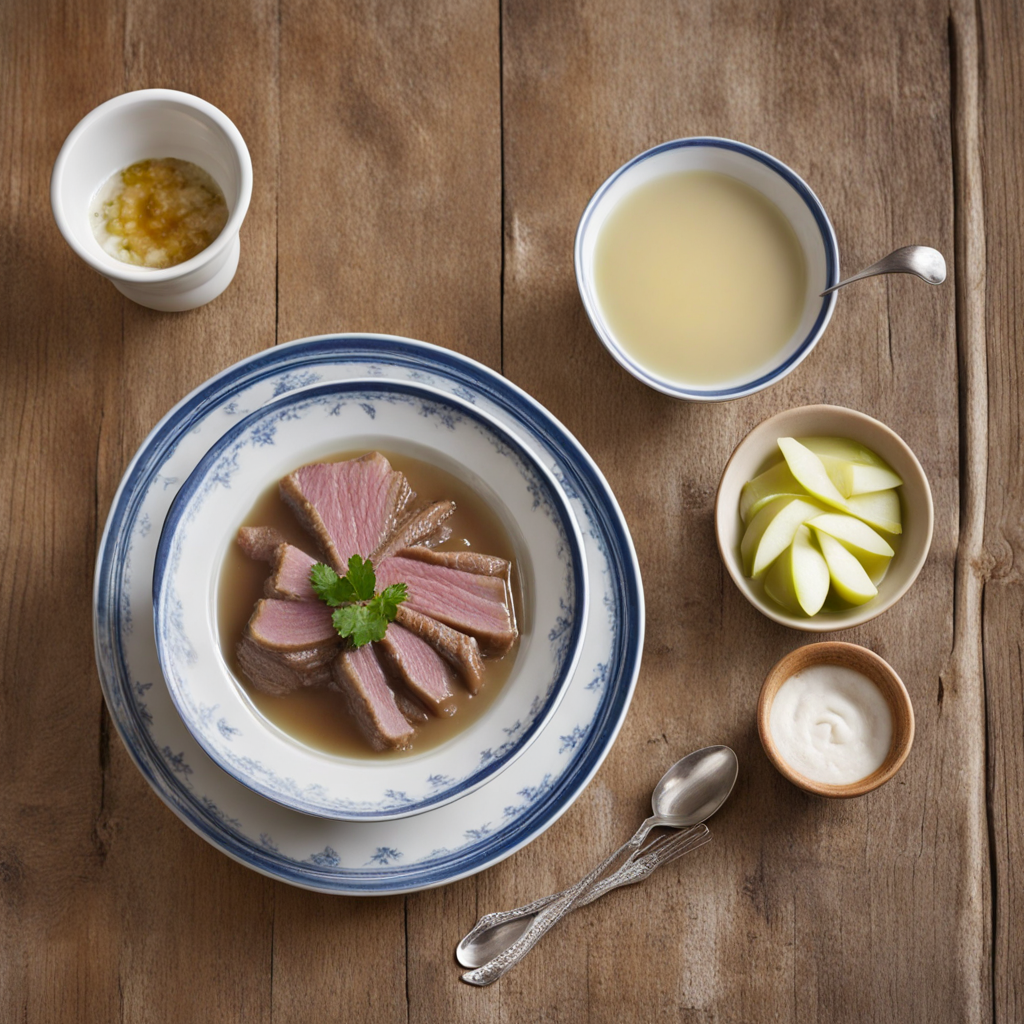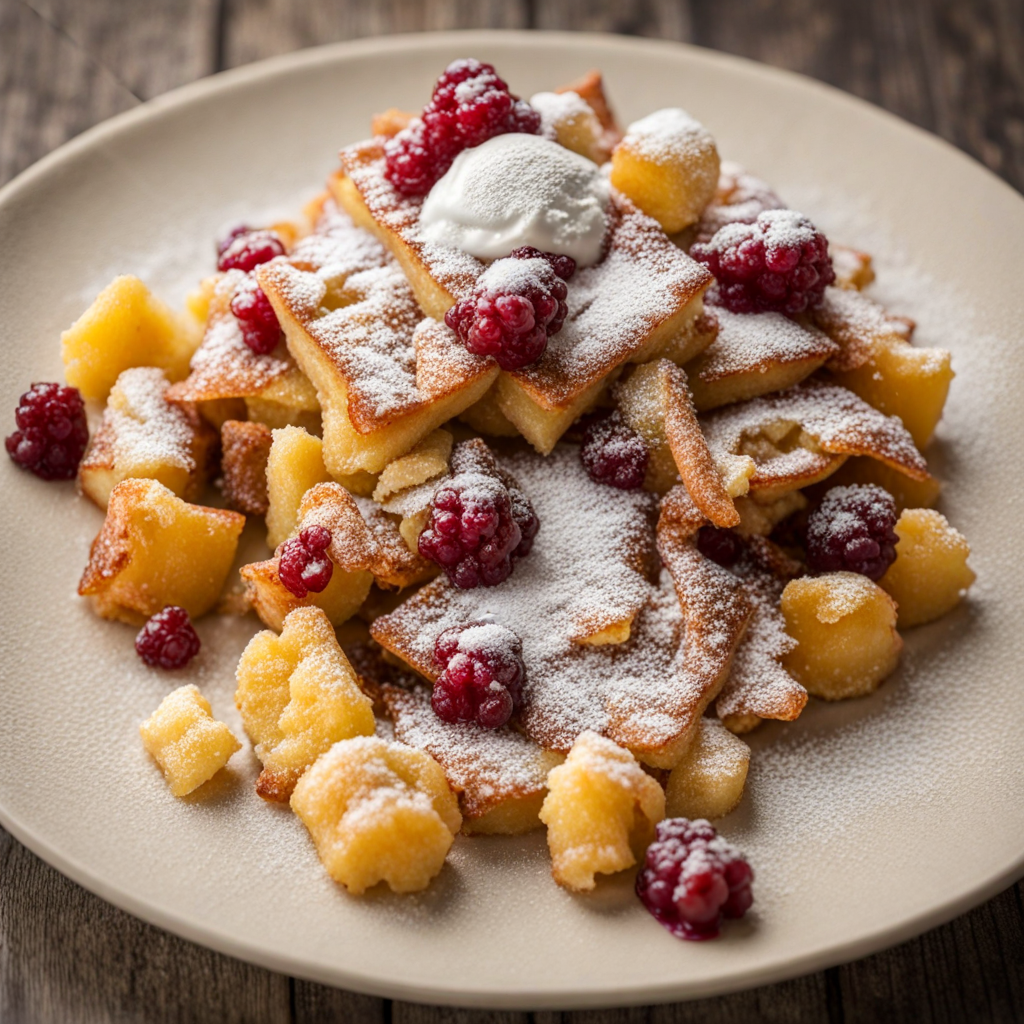Zwetschkenknödel
Zwetschkenknödel, a delightful Austrian dish, is a sweet dumpling that captures the essence of summer with its use of ripe plums, known as Zwetschken in German. These plums are enveloped in a tender, delicate dough, typically made from potatoes or flour, which gives the dumplings a soft and pillowy texture. The plums are often halved and pitted before being wrapped in the dough, creating a delightful surprise of juicy fruit at the center of each dumpling. When cooked, the dumplings take on a slight sheen, inviting you to savor their deliciousness.
How It Became This Dish
Zwetschkenknödel: A Delicious Journey Through Austrian Culinary History #### Origins of Zwetschkenknödel Zwetschkenknödel, or plum dumplings, are a beloved dish in Austrian cuisine, particularly associated with the regions of Lower Austria, Styria, and Upper Austria. The dish consists of a sweet dough, often made with potatoes or flour, wrapped around a ripe and juicy plum (zwetschke), which is then boiled and often finished with a sprinkle of sugar and breadcrumbs. The history of Zwetschkenknödel can be traced back to the 18th century when potatoes were first introduced to Europe from the Americas. Initially met with skepticism, the potato quickly became a staple in Austrian kitchens, particularly after the famines of the late 18th century highlighted the need for reliable food sources. Austrian cooks began experimenting with various forms of potato dumplings, which were initially savory but soon evolved into sweet variations, leading to the creation of Zwetschkenknödel. #### Cultural Significance Zwetschkenknödel is more than just a dish; it represents a cultural connection to the land and its produce. Plums, particularly the zwetschke variety, thrive in the temperate climate of Austria, which is characterized by warm summers and cold winters. The harvest season for plums generally runs from late summer to early autumn, making the dish a seasonal delight. In Austrian culture, food often plays a vital role in community gatherings and family traditions. Zwetschkenknödel is frequently prepared during harvest festivals and family gatherings, where generations come together to enjoy the fruits of their labor. The act of preparing the dumplings itself is a communal activity, often passed down through families, ensuring that the recipe and the memories associated with it endure. Furthermore, Zwetschkenknödel is emblematic of the larger culinary tradition in Austria that celebrates the use of local and seasonal ingredients. The dish is often enjoyed as a main course or dessert, reflecting the Austrian penchant for hearty, comforting food that brings people together. #### Development Over Time The evolution of Zwetschkenknödel reflects broader shifts in Austrian culinary practices. As the dish gained popularity, variations began to emerge, each one showcasing local ingredients and culinary techniques. In the early 20th century, the dish became more widespread and was often featured in cookbooks and culinary publications. Different regions of Austria began to develop their own takes on the classic recipe. For example, while the basic ingredients remained the same, some variations included the addition of different spices or flavorings, such as cinnamon or vanilla, to enhance the sweetness of the plums. The post-World War II era saw a resurgence in traditional Austrian cuisine, which coincided with a growing appreciation for regional gastronomy. Chefs and home cooks alike began to explore and revive traditional recipes, leading to an increased emphasis on authenticity and local sourcing. Zwetschkenknödel found its place not just in family kitchens but also in restaurants that sought to highlight Austrian culinary heritage. #### Modern Interpretations Today, Zwetschkenknödel continues to be celebrated, both in homes and restaurants across Austria. Chefs have embraced the dish, offering modern spins that still pay homage to its roots. Some variations include using different types of dough, such as a combination of potato and quark, or incorporating other fruits like apricots or cherries. The dish has also gained international recognition, with Austrian restaurants and food festivals showcasing Zwetschkenknödel as a quintessential representation of Austrian cuisine. Food enthusiasts and tourists are drawn to this dish, eager to experience the flavors of Austria's culinary landscape. #### Zwetschkenknödel in Popular Culture In contemporary Austria, Zwetschkenknödel has transcended its humble origins to become a symbol of national pride. Its presence in food festivals, cooking shows, and culinary competitions highlights its status as a staple of Austrian gastronomy. The dish is often featured in traditional Austrian menus and has been embraced by chefs who aim to bring Austrian cuisine to a global audience. Moreover, the dish has inspired a range of culinary products, from ready-made dumplings available in supermarkets to gourmet versions served in high-end restaurants. This versatility speaks to the dish's enduring appeal and adaptability, allowing it to remain relevant in a rapidly changing culinary landscape. #### Conclusion Zwetschkenknödel is more than just a delicious treat; it is a culinary artifact that tells the story of Austria's agricultural heritage, cultural practices, and evolving food traditions. From its humble beginnings as a simple, hearty dumpling to its status as a cherished dish celebrated across the nation, Zwetschkenknödel embodies the spirit of Austrian cuisine. As we look to the future, Zwetschkenknödel will undoubtedly continue to evolve, yet its essential character—rooted in community, seasonal produce, and a connection to the land—will ensure its place in the hearts and kitchens of Austrians for generations to come. Whether enjoyed during a family gathering or as part of a festive celebration, Zwetschkenknödel remains a delicious reminder of the rich culinary tapestry that is Austria.
You may like
Discover local flavors from Austria







